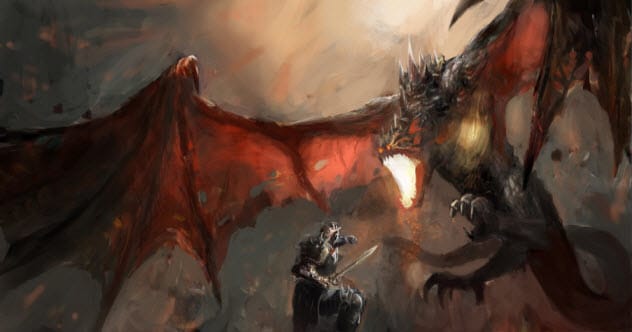Are you fascinated by dragons? British folklore is filled with tales of these magnificent and terrifying creatures. While Beowulf and Saint George are famous dragon slayers, many other dragons appear throughout the folklore of England, Wales, and Scotland. Many of these dragons, often called “worms,” have stories linked to specific locations throughout the UK, becoming integral parts of local folktales passed down through generations. Here are ten dragons from British folklore that will capture your imagination.
The Red And White Dragons
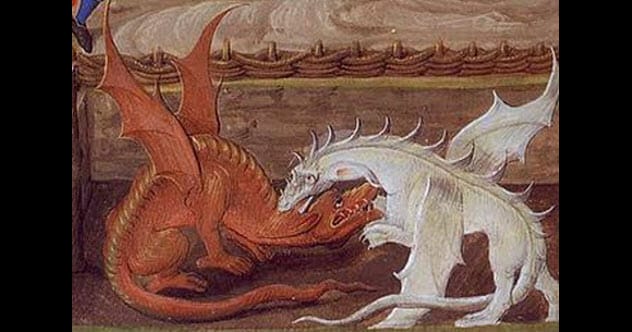 The red dragon is a powerful symbol of Welsh identity, emblazoned on the country’s flag. These dragons, along with a white dragon, appear in The Mabinogion, an early example of British prose literature and a significant collection of Welsh mythology.
The red dragon is a powerful symbol of Welsh identity, emblazoned on the country’s flag. These dragons, along with a white dragon, appear in The Mabinogion, an early example of British prose literature and a significant collection of Welsh mythology.
In the tale “Lludd and Llefelys,” the red and white dragons are at war. The white dragon’s cries cause miscarriages, kill livestock, and ruin crops. King Lludd of Britain seeks help from his brother Llefelys in France, who advises him to create a pit filled with mead covered with cloth.
The white dragon drinks the mead, falls into a stupor, and is captured by Lludd, who imprisons it in Dinas Emrys, a wooden hillock in Wales. The red dragon is often interpreted as the native Celtic inhabitants, while the white dragon represents the Anglo-Saxons who invaded England in the fifth century.
Dragon Of Loschy Hill
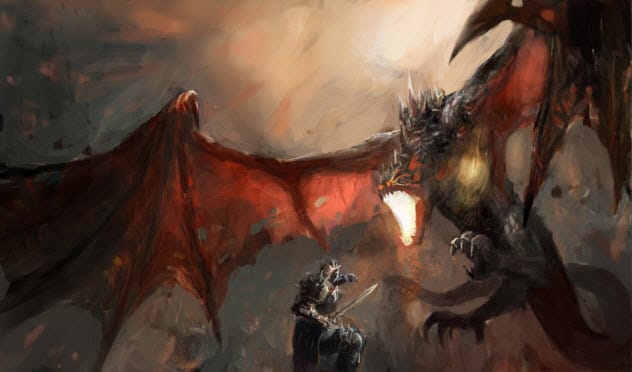 “The Dragon of Loschy Hill” is a tragic Yorkshire tale from Reverend Thomas Parkinson’s Yorkshire Legends and Traditions. A large dragon haunted Loschy’s Hill in Stonegrave, terrorizing villagers. A brave knight named Peter Loschy decided to kill the beast.
“The Dragon of Loschy Hill” is a tragic Yorkshire tale from Reverend Thomas Parkinson’s Yorkshire Legends and Traditions. A large dragon haunted Loschy’s Hill in Stonegrave, terrorizing villagers. A brave knight named Peter Loschy decided to kill the beast.
Wearing special armor fitted with razor blades, Loschy and his dog confronted the dragon. The dragon wrapped itself around Loschy, but the armor cut the dragon, though the wounds healed quickly. Despite this, Loschy managed to cut off pieces of the dragon’s skin, which his dog carried to Nunnington Church.
They dismembered the dragon so thoroughly that it couldn’t regenerate. Overjoyed, Loschy didn’t realize his face was covered in the dragon’s poison. The faithful dog licked his master’s face, ingested the poison, and died. The poison fumes also overcame Loschy, and he died by his dog’s side. Grateful villagers buried Loschy and his dog in Nunnington Church, where stone engravings retell the story.
Sockburn Worm
 The Sockburn worm is actually a wyvern, a relative of the dragon. Wyverns are depicted as smaller creatures with a dragon’s head, snake’s body, bat’s wings, and two legs. The Sockburn worm terrorized the area around the River Tees in County Durham after the Norman Conquest.
The Sockburn worm is actually a wyvern, a relative of the dragon. Wyverns are depicted as smaller creatures with a dragon’s head, snake’s body, bat’s wings, and two legs. The Sockburn worm terrorized the area around the River Tees in County Durham after the Norman Conquest.
The Sockburn worm used its ability to fly and its poisonous breath to wreak havoc. To save the realm, Sir John Conyers visited a church and offered his only son’s life to God in preparation for battle. He killed the wyvern and earned land and a title.
Some historians believe the Sockburn worm represents a marauding Danish warrior, while Conyers is seen as a Norman knight legitimizing Anglo-French rule. The weapon Conyers used, the Conyers falchion, is still displayed in Durham Cathedral.
Mester Stoor Worm
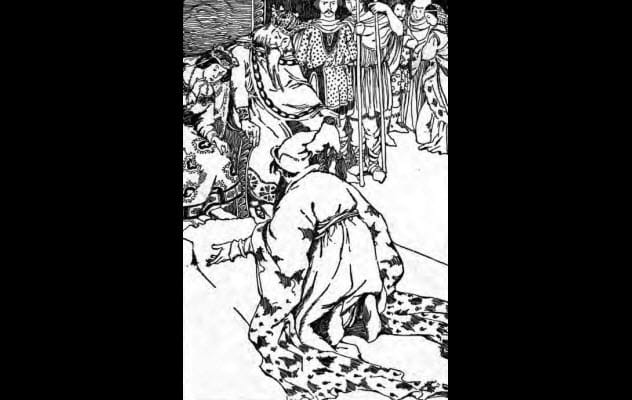 In the Orkney Islands of Scotland, the Mester Stoor Worm is a gigantic sea serpent that could wrap around the entire world. Its movements caused earthquakes and natural disasters. Most knights avoided the monster due to its poisonous breath and habit of smashing ships.
In the Orkney Islands of Scotland, the Mester Stoor Worm is a gigantic sea serpent that could wrap around the entire world. Its movements caused earthquakes and natural disasters. Most knights avoided the monster due to its poisonous breath and habit of smashing ships.
A wizard promised the king the beast could be killed if the king gave up his daughter. The king instead offered his kingdom to any warrior who could kill the Mester Stoor Worm. Assipattle, a slow-witted farm boy, killed the dragon by guiding a ship into its stomach and applying burning peat to its liver, causing an explosion.
The legend says the dragon’s scattered teeth created the Orkney Islands.
Bignor Hill Dragon
 Little is known about the Bignor Hill dragon. In the 19th century, The Gentleman’s Magazine recorded that inhabitants of Bignor Hill in Sussex believed an ancient Celtic dragon lived on a nearby hill.
Little is known about the Bignor Hill dragon. In the 19th century, The Gentleman’s Magazine recorded that inhabitants of Bignor Hill in Sussex believed an ancient Celtic dragon lived on a nearby hill.
Some tales said the surrounding hills were the dragon’s skinfolds, while others placed its den near a ruined Roman villa. This suggests the dragon might be a symbol of resistance against the Roman occupation of Britain or a demonization of pagan practices. Sussex is rich in dragon tales.
Lyminster Knucker
 Lyminster, Sussex, was home to a knucker, a type of water dragon often found in knuckerholes (ponds). The Lyminster knucker lived near the major church of Lyminster and terrorized the village by snatching livestock and young girls until only the king’s daughter remained.
Lyminster, Sussex, was home to a knucker, a type of water dragon often found in knuckerholes (ponds). The Lyminster knucker lived near the major church of Lyminster and terrorized the village by snatching livestock and young girls until only the king’s daughter remained.
The king of Sussex offered his daughter as a prize for anyone who could slay the dragon. Three versions of the legend exist: a wandering knight, Jim Puttock, or Jim Pulk kill the dragon by feeding it poisoned pudding. In one version, the hero dies from the dragon’s poison.
St. Mary Magdalene’s Church in Lyminster is known as the home of the “Slayer’s Slab,” a tomb housing the bones of the dragon slayer.
Laidly Worm Of Spindleston Heugh
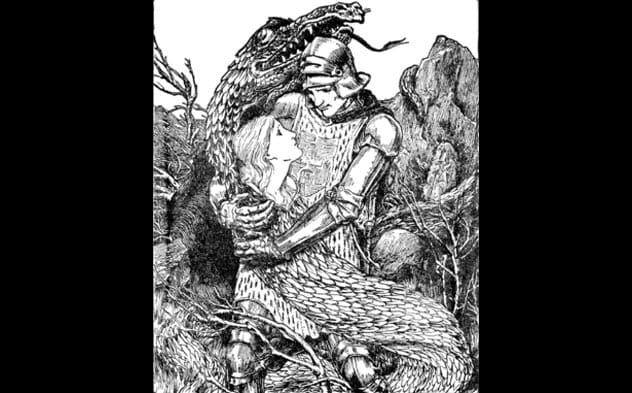 “The Laidly Worm of Spindleston Heugh” is a Northumbrian ballad. The story begins with the king of Northumbria, who lived in Bamburgh Castle. After his first queen died, the king married a malicious witch. Jealous of Princess Margaret, the witch turns her into a dragon.
“The Laidly Worm of Spindleston Heugh” is a Northumbrian ballad. The story begins with the king of Northumbria, who lived in Bamburgh Castle. After his first queen died, the king married a malicious witch. Jealous of Princess Margaret, the witch turns her into a dragon.
Princess Margaret remains a dragon until Childe Wynd returns and kisses her, breaking the spell and allowing him to claim the throne. He then curses the witch and turns her into a toad.
In another version, Princess Margaret becomes an uncontrollably hungry dragon that feasts on livestock. Both versions are inspired by the Icelandic saga of the shape-shifter Alsol and her lover Hjalmter.
The Mordiford Wyvern
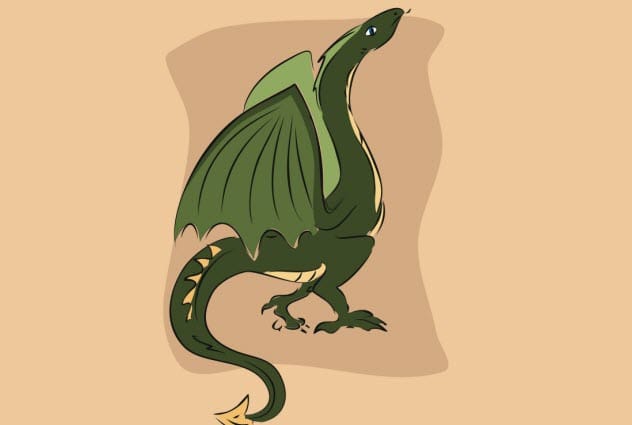 The story of Maud and the Mordiford wyvern is an unusual legend from Herefordshire. Maud finds a baby wyvern while walking one morning and takes it home as a pet, feeding it milk.
The story of Maud and the Mordiford wyvern is an unusual legend from Herefordshire. Maud finds a baby wyvern while walking one morning and takes it home as a pet, feeding it milk.
As the wyvern grows, it develops a taste for human flesh and begins eating the villagers. Despite its cruelty, the wyvern remains loyal to Maud and refuses to eat her. However, even Maud cannot stop its killing spree. It lives on a nearby ridge, and its movements create the Serpent Path, a twisting road to a local river.
Versions of the wyvern’s demise vary. In one, a member of the Garston family kills it in an ambush. In another, a condemned criminal kills the wyvern to escape punishment.
The Dragon Of Longwitton
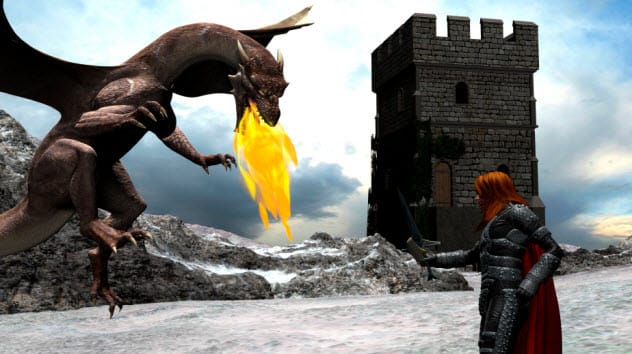 The inhabitants of Longwitton, Northumberland, were barred from three holy wells by a fearsome dragon. Sir Guy, Earl of Warwick, accepted the task of killing the dragon. For three days, Sir Guy fought the dragon, but his attacks had no effect because the dragon healed its wounds with magic.
The inhabitants of Longwitton, Northumberland, were barred from three holy wells by a fearsome dragon. Sir Guy, Earl of Warwick, accepted the task of killing the dragon. For three days, Sir Guy fought the dragon, but his attacks had no effect because the dragon healed its wounds with magic.
On the third day, Sir Guy noticed the dragon kept its tail in one of the wells, drawing on the sacred waters to heal. Sir Guy lured the dragon away from the wells, leaving it vulnerable. Away from the holy waters, Sir Guy easily killed the creature.
The waters were known for their healing properties throughout Northumbria, and the dragon coveted the wells. Sir Guy also used a magic ointment to protect himself from the dragon’s breath.
Worm Of Linton
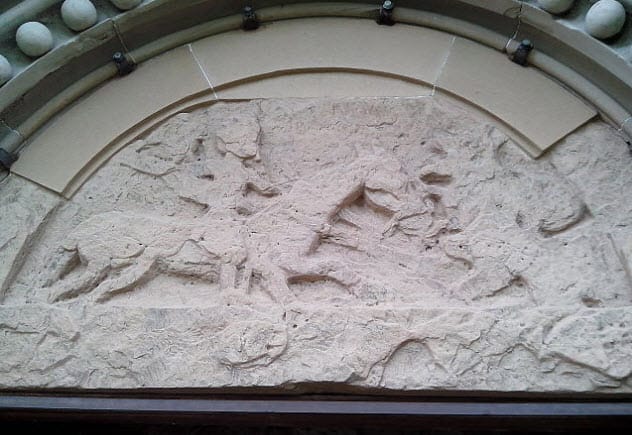 In 12th-century stories from the Scottish Borders, the Linton worm lived near Linton in Roxburghshire. At dusk and dawn, the dragon preyed on sheep, cows, and people. All weapons proved useless, and Linton became a wasteland.
In 12th-century stories from the Scottish Borders, the Linton worm lived near Linton in Roxburghshire. At dusk and dawn, the dragon preyed on sheep, cows, and people. All weapons proved useless, and Linton became a wasteland.
William (or John) de Somerville, the Laird of Lariston, decided to act. He noticed the dragon consumed everything but would lie still with its mouth open when faced with something too large. De Somerville had a blacksmith create an iron spear with a wheel on its tip, placing burning peat on the wheel.
He rode into the worm’s mouth and placed the fire inside, creating a fatal wound. The Linton worm’s thrashing body created the hills that populate the region today. Linton Church created a carved stone to record the story. King William the Lion supposedly greeted de Somerville as “my gallant Saint George.” The de Somerville coat of arms features a green, fire-breathing dragon.
Embark on Your Own Dragon Quest
These ten dragons from British folklore offer a glimpse into the rich tapestry of myths and legends that have shaped the UK. From the symbolic red dragon of Wales to the terrifying worms of Scotland and England, these stories continue to captivate and inspire.
Which of these dragons do you find most fascinating? Leave your comment below and share your favorite dragon tales!


